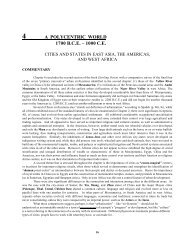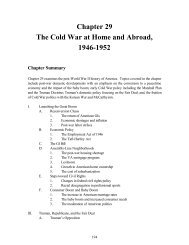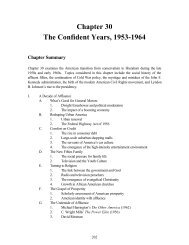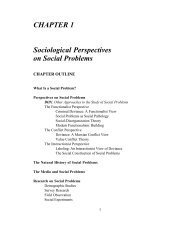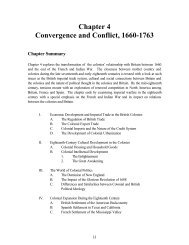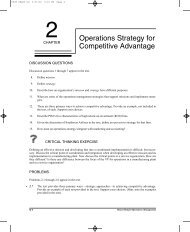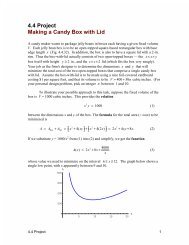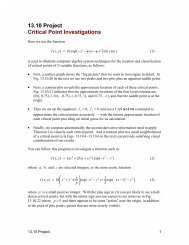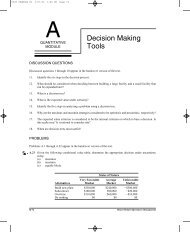Merchandising Operations and the Accounting Cycle - Pearson
Merchandising Operations and the Accounting Cycle - Pearson
Merchandising Operations and the Accounting Cycle - Pearson
You also want an ePaper? Increase the reach of your titles
YUMPU automatically turns print PDFs into web optimized ePapers that Google loves.
OBJECTIVE 2<br />
Account for <strong>the</strong> purchase <strong>and</strong><br />
sale of inventory under <strong>the</strong> perpetual<br />
inventory system<br />
226 Part One The Basic Structure of <strong>Accounting</strong><br />
Inventory Systems:<br />
Perpetual <strong>and</strong> Periodic<br />
There are two main types of inventory accounting systems: <strong>the</strong> periodic system <strong>and</strong><br />
<strong>the</strong> perpetual system.<br />
The periodic inventory system is used by businesses that sell relatively inexpensive<br />
goods. A very small grocery store without an optical-scanning cash register<br />
to read UPC codes does not keep a daily running record of every loaf of bread <strong>and</strong><br />
package of bacon that it buys <strong>and</strong> sells. The cost of record keeping would be overwhelming.<br />
Instead, grocers count <strong>the</strong>ir inventory periodically—at least once a year—<br />
to determine <strong>the</strong> quantities on h<strong>and</strong>. The inventory amounts are used to prepare<br />
<strong>the</strong> annual financial statements. Businesses such as restaurants <strong>and</strong> small retail stores<br />
also use <strong>the</strong> periodic inventory system. The end-of-chapter supplement covers <strong>the</strong><br />
periodic inventory system. That system is being used less <strong>and</strong> less as more businesses<br />
keep <strong>the</strong>ir inventory records by computer.<br />
Under <strong>the</strong> perpetual inventory system, <strong>the</strong> business maintains a running record<br />
of inventory <strong>and</strong> cost of goods sold. This system achieves control over expensive<br />
goods such as automobiles, jewellery, <strong>and</strong> furniture. Recently, <strong>the</strong> low cost of computer<br />
information systems has increased <strong>the</strong> use of perpetual systems. Computers<br />
reduce <strong>the</strong> time required to manage inventory <strong>and</strong> thus increase a company’s ability<br />
to control its merch<strong>and</strong>ise. But even under a perpetual system <strong>the</strong> business<br />
counts <strong>the</strong> inventory on h<strong>and</strong> at least once a year. The physical count establishes <strong>the</strong><br />
correct amount of ending inventory, which may have been affected by pilferage or<br />
spoilage, <strong>and</strong> serves as a check on <strong>the</strong> perpetual records.<br />
The following chart compares <strong>the</strong> perpetual <strong>and</strong> periodic systems:<br />
Perpetual Inventory System<br />
• Keeps a running record of all goods<br />
bought <strong>and</strong> sold (units <strong>and</strong> price).<br />
• Inventory counted at least once a year.<br />
• Used for all types of goods.<br />
Periodic Inventory System<br />
• Does not keep a running record of all<br />
goods bought <strong>and</strong> sold.<br />
• Inventory counted at least once a year.<br />
• Used for inexpensive goods.<br />
Computerized Inventory Systems<br />
A computerized inventory system can keep accurate, up-to-date records of <strong>the</strong><br />
number <strong>and</strong> cost of units purchased, <strong>the</strong> number <strong>and</strong> cost of units sold, <strong>and</strong> <strong>the</strong><br />
quantities <strong>and</strong> cost on h<strong>and</strong>. Inventory systems are often integrated with accounts<br />
receivable <strong>and</strong> sales. The computer can keep up-to-<strong>the</strong>-minute records, so managers<br />
can call up current inventory information at any time. For example, in a perpetual system<br />
<strong>the</strong> “cash register” at Zellers or The Bay is a computer terminal that records <strong>the</strong><br />
sale <strong>and</strong> also updates <strong>the</strong> inventory records. Bar codes, which are scanned by a laser,<br />
are part of <strong>the</strong> perpetual inventory system. The lines of <strong>the</strong> bar code represent coded<br />
data that keep track of each item. Because most businesses use bar codes, we base our<br />
inventory discussions on <strong>the</strong> perpetual system. 1<br />
Purchasing Merch<strong>and</strong>ise in <strong>the</strong><br />
Perpetual Inventory System<br />
The cycle of a merch<strong>and</strong>ising entity begins with <strong>the</strong> purchase of inventory, as Exhibit<br />
5-2 shows. For example, a stereo centre records <strong>the</strong> purchase of cassette players,<br />
compact disc (CD) players, <strong>and</strong> o<strong>the</strong>r items of inventory acquired for resale by<br />
1 For instructors who prefer to concentrate on <strong>the</strong> periodic inventory system, an overview starts on page<br />
247 <strong>and</strong> a comprehensive treatment of that system begins on p. 279. Follow Chapter Objectives S2<br />
through S5 instead of 2 through 4.



